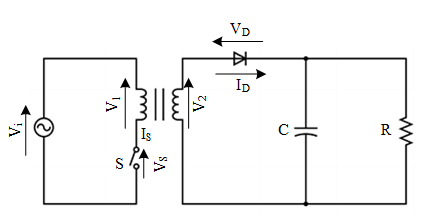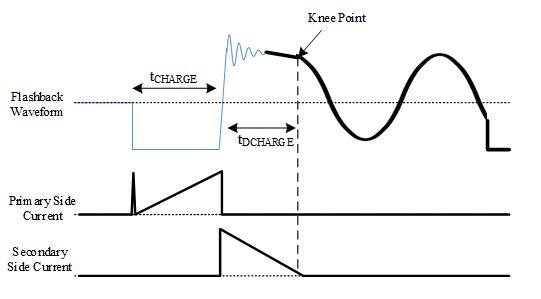Understanding Flyback Transformer
12/05/2022, hardwarebee
A flyback transformer is an energy conversion device that sends energy from one end of a circuit to the other at a constant power level. The voltage of a flyback transformer is stepped up to a very high value depending on the application. It’s also known as a line output transformer since the output line voltage is transferred to the other half of the circuit. With the help of the rectifying circuit, a DC circuit may drive the transformer’s primary winding.
A subset of the transformer family is the flyback transformer. It’s essentially a step-up transformer with a huge voltage stepping capacity. It’s more compact and portable than power transformers. When a very high voltage in the picture tube is necessary, flyback transformers are widely employed in CRT tube televisions. From a 230 V input, a flyback transformer may create an output of up to 20,000 V. It may even operate at low voltages such as 12 or 5 volts.
The flyback transformer was initially employed in a cathode ray tube to control the horizontal movement of an electron beam. A flyback transformer may now be operated with a DC pulse utilizing a rectifying circuit made up of electronic devices like MOSFETs thanks to advancements in technology and components.
Flyback Transformer Design
A flyback transformer differs from a regular transformer in its design. The design and application of a flyback transformer varies from those of a conventional transformer. The primary side of a typical transformer must be supplied an alternating current voltage that is stepped up or down depending on the number of winding turns of the secondary coil. . A conventional transformer’s output voltage is restricted, yet it can be utilized for a variety of purposes. The primary winding of a flyback transformer does not have to be driven by AC voltage; it may also be controlled by a DC pulse input. The Flyback Transformer Design is seen in the diagram.

Figure 1: the Flyback Transformer Design
A few electrical components make up a flyback transformer. At the input, a switching device made up of transistors or MOSFETs is used to turn on and off the primary coil’s input voltage. In reverse bias, the secondary coil is equipped with a diode that prevents current flow.
A flyback transformer is built in such a way that it may be activated by direct current voltage. A switch powered by a DC source drives the primary winding. The DC pulse input can be as low as 5 V or 12 V and can even be acquired from a function generator. A rectifying circuit converts the DC voltage to a DC pulse. A typical transformer’s output voltage is pure alternating current voltage. The magnetic flux is transmitted to the secondary coil when the primary coil is activated. The current is stored, however, since the secondary coil is coupled to a diode in reverse bias.
As a result, the following incoming primary winding pulse adds to the stored current (i.e the energy stored in the previous pulse). The effect of this subsequent addition is an extremely strong pulse of electricity at the output.
Winding of a Flyback Transformer
A primary winding, a secondary winding, and a core made a flyback transformer. A rectifying unit is included if it is powered by a direct current supply. When compared to secondary winding turns, primary winding turns are frequently fewer. The copper windings are separated from one another and are copper. The winding methods are the same as in conventional transformers. A series of magnetic circuits is created by windings looped around the core. This allows the transformer to handle larger voltages while yet adhering to minimal power requirements. The winding loops around the central leg, which has similar dimensions on all sides. It produces an additive magnetic circuit.
To get a very high voltage on the secondary side, secondary turns are substantially bigger than primary turns. Copper is frequently used to make windings. The windings are also properly insulated from one another, just like in a regular transformer. Mica insulation is the most frequent type of insulation. In addition to SMPS and converters, paper insulation is used in a variety of other applications. There is no oil used for insulation or colling, unlike standard transformers. The winding loss and efficiency are significant due to the small size of the windings.
Working Flyback Transformer
The flyback transformer works in the same way as a standard transformer, with the exception of design variations. As shown in the circuit design, the main winding of the transformer is activated when it is stimulated by a low voltage sawtooth waveform.
The primary inductance generates a ramp current when the primary winding is energized, as shown in the waveforms. When the ramp current reaches its maximum magnitude, the flyback waveform creates a high potential. This is induced on the secondary side. The diode on the secondary side stops the ramp from flying on the other side.
The secondary current declines on a ramp when the voltage approaches the knee point. On the secondary side, a high voltage is obtained at this moment. Because it can’t be AC in nature, it follows an arc-like shape with a very high potential, propelling the electron beam in one direction. The second potential is lesser in applications like SPMS, but the conversion principle to convert the secondary AC in switched-mode is the same. The technique can be classified as continuous or discontinuous based on the waveform characteristics.

Figure 2: Circuit Waveforms
The Flyback Transformer Principle
During the first half-cycle, a flyback transformer stores energy in the form of a magnetic field and then releases it with reverse terminal voltage. To conduct and halt energy transfer, the gadget employs a diode (also known as a flyback diode). When the primary coil switch is turned on, electrical current is generated owing to inductance. The secondary coil, which is linked in series to the flyback diode, resists the current creation. The energy is instead retained in the magnetic core.
Figure 3: When the power is turned on and off, the current changes.
Arc of the Flyback Transformer
The output voltage of the transformer is rather high, ranging from 10 to 20 kV. The high voltage is not sinusoidal, but instead takes the form of an arc. An arc emerges in the air when two highly conducting substances are placed near together. The air in between is ionized, resulting in an arc formation. The concept stays the same whether a breaker is tripped, an isolator is triggered, or the corona phenomenon happens.
Testing of Flyback Transformer
A variety of methods may be used to test a flyback transformer. A line driven potential transformer tester is used to check whether the winding has a fault. The tester will display extremely high impedance on the winding side in the event of an open winding, but relatively low impedance in the case of a short circuit.
This is one example of a winding defect. In recent tests, a graphical display will also reflect the winding’s health. It will be a loud procedure if the capacitor has a defect. On the display side, a tic-tac-toe-like noise will be heard. This occurs during the capacitor’s opening. In the event of a capacitor short, the display will be blank. A power flicker will appear. The capacitor must be changed in such circumstances.
Other typical transformer faults include winding shorting, core cracking, external arcing to ground, and so forth. All of these issues may be checked using a line-operated tester. A standard multimeter may also be used to verify the circuit’s continuity and measure the voltage at each location.
Applications of Flyback Transformer
The following are the list of flyback transformer applications.
- Television: The first flyback transformers were used in television sets in the twentieth century to regulate the horizontal electron beam of a cathode ray tube (CRT). Due to flyback transformers, modern televisions need complex components that produce a constant supply voltage.
- Aeronautics: Many aeronautical gadgets must operate at a specified frequency in order to work properly. Flyback transformers aid in the delivery of a high voltage electric supply, hence protecting the equipment.
- Telecommunications: Flyback transformers are used in telecommunication networks to convert power and electrical supply. In the telecommunications business, DC to DC power conversion is common, particularly for switching power supply.
- Inverters and converters: While electrical converters and inverters work at varying frequencies, flyback transformers aid in the conversion of low voltage current to high voltage current. They also give consistent electricity to computers, refrigerators, and air conditioners.
- Industrial Machinery: Flyback transformers, which improve efficiency and performance, are used to support a wide range of industrial equipment. They are commonly found in motors, generators, and electrical pumps.
Summary
As a consequence of technology improvements, the flyback transformer’s functioning and characteristics have become widely used, particularly in the renewable energy industry. Investigating the secondary voltage of a flyback transformer, which has huge potential for charging battery units with a low time constant, is one fascinating element. This may be performed by changing the secondary winding capacitor.









